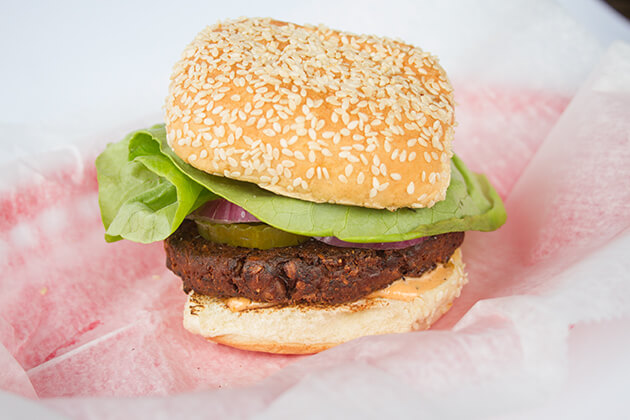The Way We’ll Eat: Tracking the Hottest Food Trends of 2016


Veggie burgers are going to be really big this year.
Just because 2015 is officially behind us, that doesn’t mean our dining habits will change on a dime. In fact, most of last year’s persistent restaurant trends—no tipping, whole grains, okonomiyaki, seaweed—will remain explicitly omnipresent in the coming months. They’ll just be joined (or in the case of fried chicken, eventually overtaken), by movements burbling just under the surface, from an increased appreciation of veggie burgers and a stage for African spice to an enhanced, all-in effort to go entirely waste free.
Hi-Tech Takeout: Seamless is so 2013. Last year, innovative companies absolutely flooded the food delivery space, from the carefully curated Caviar, which works exclusively with top-tier eateries; to the David Chang-financed Maple, a full-stack company, which offers dishes from consulting chefs like Mark Ladner and Brooks Headley; to the super-streamlined Arcade, which allows consumers to order that day’s single restaurant selection (such as noodles from Han Dynasty) simply by texting “yes.” And the market is primed to reach peak saturation next year, with Google, uberEats, and Amazon Prime Now all getting into the game.
Poke, Mon: New DOH regulations enforcing restaurants to pre-freeze fish has essentially amounted to a war on sushi, although shellfish, fresh water fish, and certain types of tuna are exempted from the rule. Which may very well pave the way for the Hawaiian dish, poke (already a favorite at the East Village’s Noreetuh, as well as the focus of a devoted Smorgasburg stand), featuring bite-sized fish cubes marinated in salt and soy and flavored with sesame oil, chilies and nuts, which should squeak by the system relatively unsullied.
Vegging Out: This past September, Pete Wells bestowed two stars on Brooks Headley’s fist-sized veggie burger shop—which likely gave grain and seitan-based patties the shot in the arm they need to finally surpass fried chicken. They’ve already begun popping up in expected places (like broccoli-obsessed No. 7 Veggie, and the vegan mini-chain, By Chloe), and even infiltrated the fine dining realm as well (check out Daniel Humm’s quinoa and lentil version at the NoMad), and if you’re jonesing for beans and greens on a bun in Brooklyn, you need only consult our best of list right here.
Chicken’s Hot, Hot, Hot: The rise of the veggie burger notwithstanding, don’t count fried chicken out just yet. In lieu of the fast food sandwich style that ruled 2015, more and more NYC chefs are taking a cue from Nashville, by appropriating their incendiary, cayenne and lard-sauced bird. It’s a burgeoning trend that already has legs—think The Heyward, Peaches HotHouse, and the Meat Hook Sandwich Shop—but look for hot chicken to proliferate in earnest in the coming months, especially in the wake of Carla Hall’s dedicated, upcoming spot in Brooklyn’s Columbia Waterfront District.
Into Africa: It may be cold comfort to Madiba, but African spices and condiments are slated to give standbys like sriracha and gochujang a run for their money in 2016. So expect to see piri piri pepper, a bird’s eye chili; vadouvan, a mix of curry leaves, coriander, turmeric, cumin and fenugreek; and berbere, an Ethiopian staple, comprising chili, garlic, ginger, korarima, rue and adjwain, enlivening all manner of globally influenced foodstuffs in the coming year.
Waste Not Want Not: In an increasing effort to be environmentally and ecologically sustainable, chefs have cycled through nose-to-tail and root-to-stem cooking, experimented with rough fish and off-cuts, and more recently, have even turned to plentiful seaweed and protein-rich bugs. But the final frontier in reduced footprint dining appears to be dumpster diving, as exemplified by Dan Barber’s month-long pop-up called WastED—which challenged guest chefs to craft innovative dishes from ignored and overlooked food byproducts. And turning garbage to gold is already a full-time pursuit at Brooklyn’s recently opened Saucy by Nature, which has effectively reduced almost all of it’s waste (producing only one trash bag per week) by composting and recycling, using surplus catering ingredients, and donating the rest to food pantries.
You might also like 




















